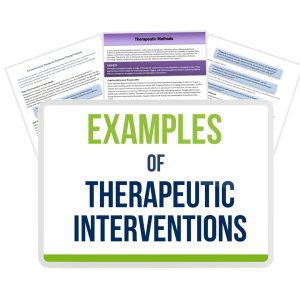
Therapeutic Interventions for Mental Health Progress Notes
Maintaining organized, legible and thorough mental health progress notes is essential for therapists and other clinicians. These notes act as a guide to monitor your patient's progress, determine the efficacy of their treatment plan and decide whether they may benefit from different therapeutic interventions. Documenting your interventions is critical for insurance, compliance and other lawful purposes, so it's important to have access to the right tools and solutions that help you efficiently create progress notes during and after each session.
Having note-writing software and templates on hand makes it easier and faster for you to initiate intervention or adjust your patient's treatment plan as needed. By speeding up your documentation time, you can also spend more time focusing on your patients and building a professional relationship with their behavioral health care teams to ensure they get the treatment they need.
What Are Therapeutic Interventions in Progress Notes?
A therapeutic intervention is a strategy that therapists, counselors and other behavioral health professionals can use to help clients that may be struggling to fully engage in their treatment. In some cases, the patient may be unable to help themselves or engage in self-destructive behavior that concerns their family members and loved ones, so it may be confrontational in nature. In other cases, the patient may agree to work on a unique intervention that specifically works for their needs and come to a solution with their therapist.
There are many different types of potential therapeutic interventions therapists can use as a tool to help manage certain behaviors, conditions or illnesses, such as:
- Eating disorders
- Substance abuse/addiction
- Dangerous sexual habits
- Dementia
- Stress-related illness
- Difficulty adhering to prescribed medication
- Mood disorders that make the patient a danger to themselves
- Self-harming
- Suicidal threats, risks or behaviors
- Other life-threatening behaviors
A therapeutic intervention can also be a deliberate decision or action that you may take with your client during the course of a regular session. The goal of these interventions is to provide a non-threatening, positive effect on the patient experiencing distress. Interventions can help modify behaviors that interfere with their well-being and safety.
Although therapeutic interventions can sometimes be staged and planned, they can also be any action that will help the patient enact positive change in a safe and structured manner. This means you can have a peaceful, respectful confrontation with your patient about their behavior and even employ a blend of techniques to meet their unique needs.
FREE DOWNLOAD - Therapeutic Interventions Guide
Discover the ultimate resource for enhancing your therapeutic practice! Our comprehensive Therapeutic Interventions Guide equips behavioral health clinicians with practical tools to strengthen client relationships, improve therapy outcomes, and deepen engagement. This guide covers effective communication techniques, goal-setting strategies, and cutting-edge therapeutic interventions like Cognitive Behavioral Therapy (CBT), Dialectical Behavior Therapy (DBT), and more. Download your free copy today and enhance your approach to therapy with evidence-based methods and tools designed to drive progress and client satisfaction.

Common Therapeutic Interventions Used in Progress Notes
As a therapist, it's important to know what therapeutic interventions you may use with your patients and what mental health conditions they can help with. If you decide to use any of these interventions, it may be useful to document how the client appears when they enter the session versus when they leave, a brief description of what you discussed and how the client is progressing toward their goals. Here are some therapeutic intervention examples you may want to try using in your therapy notes.
1. Identifying Triggers
If your patient struggles with anger or substance abuse issues, identifying triggers can be a helpful intervention. This can be done with or without the help of their family and loved ones. Simply talk to your patient about what experiences make them feel uneasy, angry or shameful.
These emotional triggers may lead to them using substances or letting their anger overwhelm them. Be sure to discuss potential coping strategies that can help them de-escalate a triggering situation.

2. Cognitive Restructuring
Cognitive behavioral therapy (CBT) is a common and effective type of psychological treatment you can use to help with a wide range of mental health problems, such as anxiety disorders, depression, eating disorders and other types of severe mental illness.
Using CBT as an intervention helps you work with your client to restructure the way they think, increasing their awareness and challenging negative thoughts to help them manage difficult emotions.
3. Anger Management
Everyone experiences anger during their lives, but certain people may display severe anger issues as a result of trauma or other mental health conditions. In some cases, your patient's anger may even cause them to become a danger to themselves and others.
Anger management as an intervention focuses on helping patients recognize that though anger is a normal, healthy emotion, expressing it in unhealthy ways can lead to additional problems. You can use this intervention to help your patient manage their anger and find healthier ways of self-expression.
4. Imagery Training
You may have one or more patients that struggle with chronic stress, anxiety or other conditions that make it difficult for them to relax. In this case, an imagery or relaxation training intervention can be useful. Have your client practice visualizing themselves in a peaceful, relaxed setting, such as their favorite place or a location they've always wanted to travel to.
Instruct them to focus on the sensory details of the experience, such as what they might see, feel, hear and smell. Some patients may also benefit from closing their eyes and envisioning themselves meeting their goals, which can help motivate them to engage in therapy.
5. Mindfulness
Often associated or combined with CBT training, mindfulness as an intervention strategy may be particularly effective for patients who struggle with anxiety, depression, suicidal ideation or intrusive thoughts. As the name suggests, mindfulness promotes being more aware and engaged in the present moment rather than losing oneself to one's thoughts or spiraling about hypothetical situations. Some examples of mindfulness therapy include breathing exercises, meditation, gratitude affirmations or self-compassion practices.
6. Communication Training
One of the most critical parts of therapy is teaching your patient how to effectively communicate their feelings and experiences in a healthy way. You may decide to use a communication training intervention on a patient if they are using unhealthy coping mechanisms as a way of expressing themselves or struggling to connect with their partner and loved ones as a result of their mental health condition.
You can use this interpersonal therapy intervention technique to validate your patient while they are opening up and use active listening to increase their comfort with communication. You may also increase the amount of open-ended questions you ask to keep the dialogue going.
7. Problem-Solving Skills Training
An effective, universal intervention technique to keep in mind during your session is helping your client improve their problem-solving skills. This cognitive behavior intervention can be used for a wide range of people who struggle to address difficult life changes, handle conflict, overcome stressful events or set boundaries with their loved ones.
You can apply this intervention using a four-step process that includes assessing your patient's current approach to problem-solving, defining the problem they need to address, brainstorming and analyzing potential solutions and implementing a realistic plan. The most important aspect of problem-solving skills training is to ensure your patient feels challenged yet equipped to follow through with this change.
Descriptive Intervention Words for Progress Notes
When using any of the interventions mentioned above, you can make your progress notes more efficient and detailed by using more descriptive words to explain what occurred during your session. Using common intervention words in combination with behavioral health documentation software can streamline your note-writing process. Here is a list of some actionable words to reference and include in your behavioral health documentation when implementing an intervention.
- Assisted client in
- Acknowledged
- Affirmed
- Clarified
- Collaborated
- De-escalated
- Demonstrated
- Developed
- Discussed
- Encouraged
- Examined
- Evaluated
- Facilitated
- Guided
- Instructed
- Introduced
- Listened
- Planned
- Practiced
- Provided
- Redirected
- Reflected
- Reinforced
- Reviewed
- Role played
- Set boundaries
- Shared
- Supported
- Validated
Take Effective Progress Notes With ICANotes EHR Software
No matter which intervention you use for your patient, it's important to keep each of your sessions well-documented so you can see how they are progressing and adjust their treatment plan as needed. However, spending hours on documentation can interrupt your flow and prevent you from spending as much time as possible with your patients.
With ICANotes, you can efficiently and effectively document your interventions in your progress notes with our therapy note-writing templates and assessment tools. ICANotes is the premier EHR for the behavioral health specialty, providing you with an intuitive, robust charting solution that meets all your needs and reduces the documentation burden, so you can focus on what matters most. Schedule a demo today or start your free trial to see how our solution can benefit your practice.
Start your free trial today. No credit card required!

